Recent Comments
Archives
Categories
- No categories
Meta
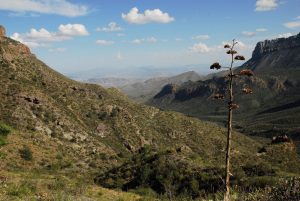
Big Bend National Park courtesy of Texas Mountain Trail
Alpine is at the center of a vast, diverse community, connected by the most scenic routes in the state. Reach out to the national and state parks that celebrate the natural beauty of west Texas, or take a quick jaunt to sample the other cities of the region, each with a flavor all their own.
- Day Trips
- Alpine Murals
- Alpine Cowboys Baseball
- Live Music
- Historic Walking Tour
- Hancock Hill Trails
- Alpine City Parks
- 2024 Summer Activities for Kids
- Museum of the Big Bend
- Alpine Farmers Market
- Big Bend Parks
- Chihuahuan Desert Nature Center
- McDonald Observatory
- Photographing the Big Bend
- Balmorhea State Park
- Rocks & Gems
- Fort Davis National Historic Site
- Marfa Art Scene
Day Trips
Tri-County Triangle – Take a trip through the historic county seats of the Big Bend region and get a feel of the unique experiences West Texas has to offer. (Click for Details)
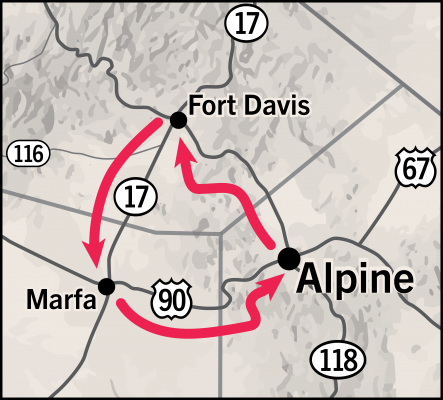
Big Bend National Park Driving Loop – See the beautiful vistas and rugged old towns of Brewster County and Big Bend National Park. (Click for Details)
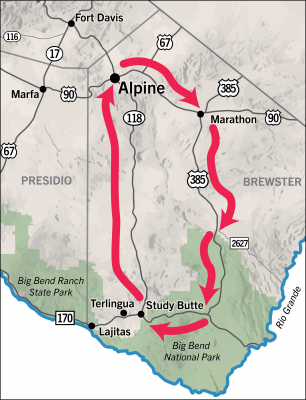
Alpine Murals
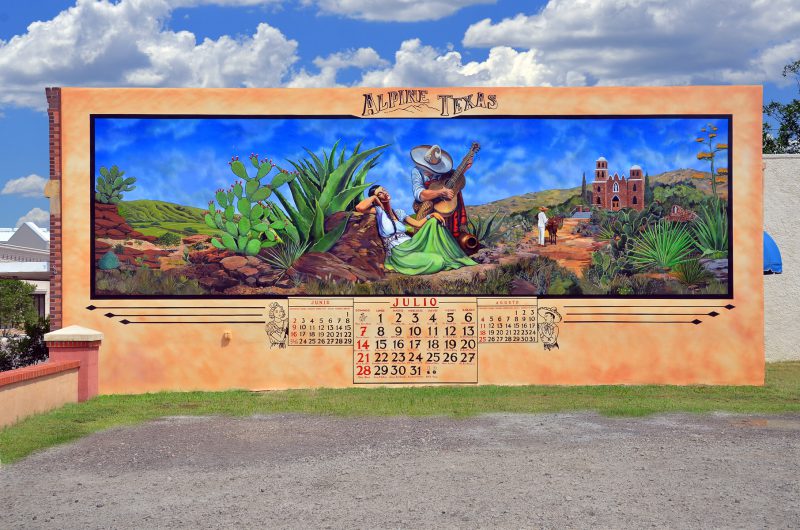
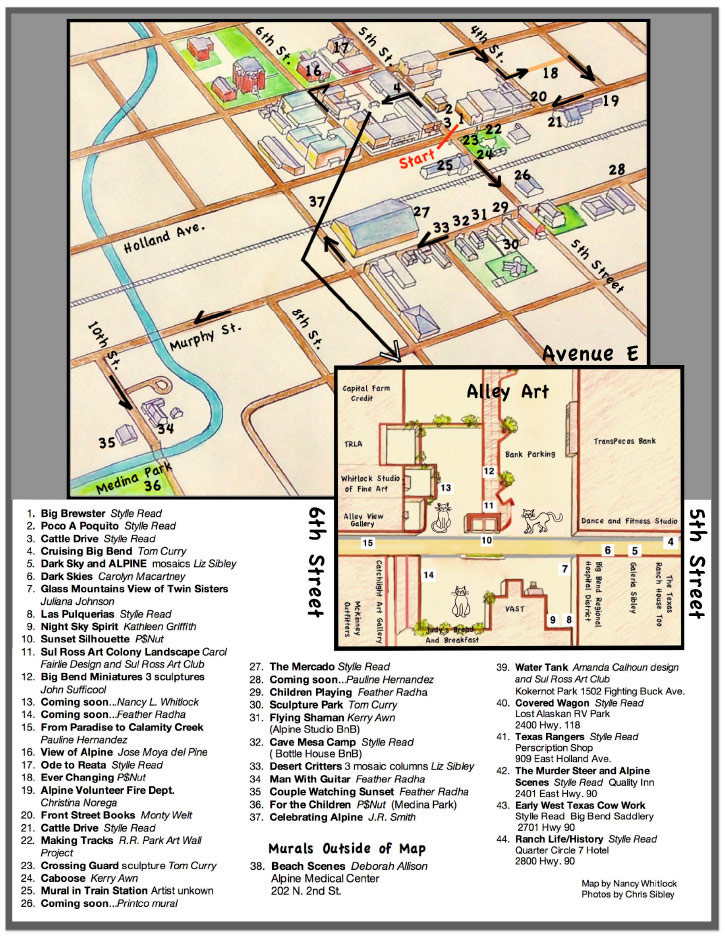
The Alpine Downtown Association has created a walking tour of Alpine’s downtown murals (above). Click here to download a printable PDF file.
Take a stroll downtown and look around. Works of art adorn the walls of many local businesses around Alpine, revealing glimpses of local history and folklore, because after all, a picture, or in this case, an image, is worth a thousand words.
There’s a historic map of the Big Bend region inside the Museum of the Big Bend painted by Enrique Espinoza in 1940.
“View of Alpine” was painted by Jose Moya del Pine in 1940 inside the then-post office (it’s now the Brewster County Tax Appraisal’s office. Local artist Deborah Allison painted a tropical paradise in the Chihuahuan Desert on two sides of the Alpine Medical Center.

At the stoplight on Holland Avenue and 5th Street, two murals are perpendicular to each other. Facing west, on the wall of Kiowa Gallery, is “Big Brewster,” which welcomes visitors with an introduction of Brewster County. Images of defining faces and places such as the CF Ranch (a nod to the ranching heritage), Big Bend National Park that sits south of the county along the Mexico border and a steamroller train to signify the first laid tracks in 1882.
TV actor Dan Blocker smiles in his portrait as he dons a white cowboy hat in the mural. Most known for his role as Hoss Cartwright on Bonzana, Blocker graduated from Sul Ross State Teacher’s College in 1950 where he also played football. Another notable local sports figure, Herbert Kokernot, stands with a member of the Alpine Cowboys baseball team he founded in 1947. Kokernot, an 06 Ranch owner, also built the Kokernot Field on E. Hendryx Dr and Fighting Buck Ave.
Also on the mural, a Sul Ross State University banner hangs above a picturesque postcard that reads “Greetings from Alpine, Texas.” It’s a favorite spot for that Instagram photo.
“I love it,” said Kiowa Gallery’s owner, Keri Blackman. “You come out on a Sunday and there is a group standing there taking pictures of their families.”
The other mural facing south, is one of the three murals Blackman gifted to the city for the 20th anniversary of Artwalk, an annual art festival in downtown Alpine. In 2013, Blackman had an idea to paint a mural in a weekend to give back to the town. The mural, called “Poco a Poquito,” used a traditional Mexican calendar top with a man serenading a woman. Muralist Stylle Read redesigned it to include Our Lady of Peace Catholic Church in the background. The church stands directly south of the mural.

Blackman enlisted the help of Read and local volunteers to paint what would be the first of the six murals. The Mercado Mural came next in 2014 at the Big Bend Wool and Mohair on Murphy Street. Located in the revitalized neighborhood with old and new businesses, four calendar tops were combined to create a market scene.
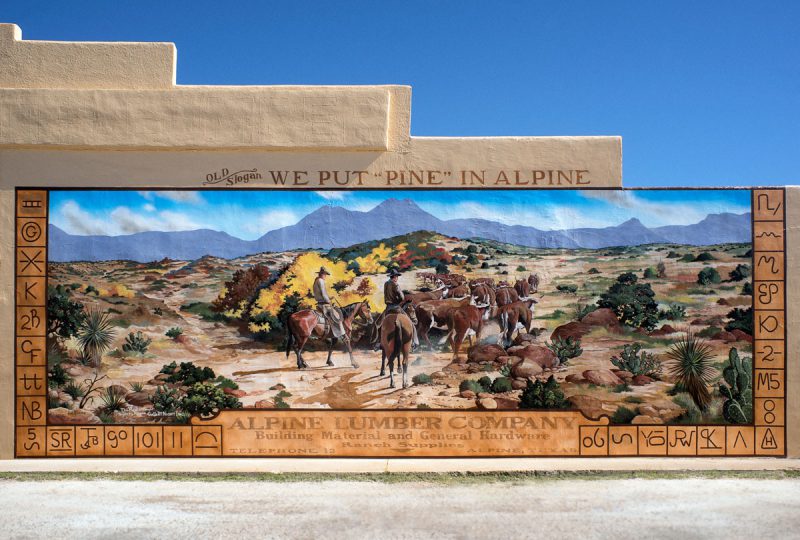
The Cattle Drive Mural was completed in 2015 and reflects the region’s ranching heritage on the current KishMish Plaza, but the calendar image came from an actual calendar Alpine Lumberyard used to produce when it was there in the 1950s.
Read also worked on previous projects for others in the past. The first thing Read painted in Alpine was the West Texas themed mural near the Crystal Bar entrance. It was then owned by Larry McAllister in the spring of 1989.
Read is also the artist behind “Ode to Reata” at Reata Restaurant that features the house from the West Texas epic “Giant” and actor James Dean on a horse.
More recently, a group of businesses and building owners have partnered together for “Alpine Alley Art”. An alley runs east-west through downtown Alpine between Holland Avenue and Avenue E. The block between 5th and 6th Streets is quickly being filled with multiple murals, including a desert nature scene by Pauline Hernandez with ceramic details, a celebration of Big Bend’s Dark Skies by Carolyn Macartney and Liz Sibley, a mountain landscape by Juliana Johnson and more!
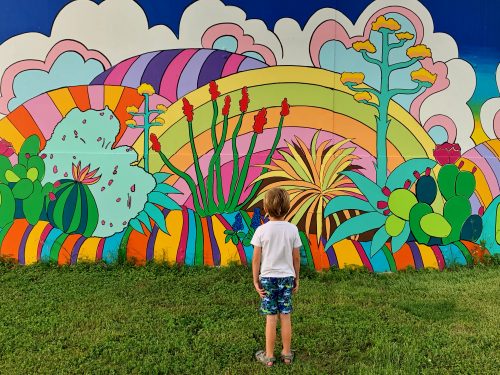
At Kokernot Park, Alpine’s premier municipal park, the Sul Ross Art Club produced a pop-inspired design by Alpine artist Amanda Calhoun on a water tank at the park’s southeast corner.
Guests at the Quality Inn are greeted with images of Alpine and the origin of the “murder steer” legend in the hotel’s lobby, also painted by Read in 1995.
The goal for future murals is to celebrate Texas-born musicians at Printco with the design as a spinoff of The Beatles “Sgt. Pepper’s Lonely Hearts Club Band” album cover. Meaning, there will be a lot of musicians to paint.
Another mural is to honor the Texas Rangers, specifically the late Joaquin Jackson, who was a native of Alpine, at Prescription Shop.
As for Read, he would like to do more historic murals in general.
“I would love to do one of Herbert Kokernot and the story of the old Cowboys and the Kokernot Field,” said Read. “You know, there’s always something. Name the subjects and it’s a possibility.”
Article by Sarah Vasquez
Alpine Cowboys Baseball
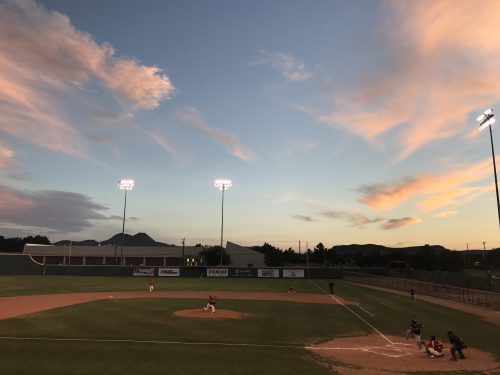
It’s been their summer tradition since 2013. Victor and Janice Pepka jump in their RV and travel close to 500 miles (or seven hours) from the small town of Whitney for America’s Favorite Pastime in Alpine. Even though it’s a much shorter distance to watch a Texas Rangers game in nearby Arlington, the Pepkas would rather travel to Far West Texas. To them, watching an Alpine Cowboys baseball game is a special treat.
“This is just fun,” said Janice.
There’s been some embodiment of baseball in Alpine since 1905, but the Cowboys have been a part of the town’s history since 1947 when longtime rancher Herbert Kokernot Jr. built a baseball stadium known as Kokernot Field. Kokernot wanted to replicate his field after Wrigley Field in Chicago and used materials from his ranch to add that personal touch. After all, his father told him, if he was going to use their 06 brand on the field, he had better do it right. Rocks from the ranch were used to build the walls. The brand adorns the doors and gates and is used as the team’s logo. Kokernot erected lights a couple of years later in 1958.
Located north of downtown, Kokernot Field has been called the “best little ballpark in Texas” by Sports Illustrated. Four flags – an American flag, a Texas flag and two Alpine Cowboys flags – stand tall above the words “Kokernot Field – Home of the Cowboys” at the entrance. There’s a car entrance on the first base line where the cars used to pull into the stadium to watch the game. Walking up the ramp to the stands, the field welcomes the crowd with a view of the surrounding mountains that define West Texas.
“This is out in the middle of nowhere,” said Kristin Lacy Cavness, Cowboys’ current general manager.
Cavness is Kokernot’s great granddaughter. Growing up on the 06 Ranch, Cavness got to see her great-grandfather quite a bit, so baseball has always been a part of her life.
“He had a love for baseball,” said Cavness.
It was that love that inspired him to renovate the stadium of the Alpine Cats, the town’s former semi-professional baseball team, into what would become Kokernot Field and to bring back the team as the Alpine Cowboys in 1947 until it folded in 1961. The Cowboys returned 48 years later in 2009 in a failed attempt as a for-profit professional baseball team before their successful relaunch as a nonprofit in 2011.
“Most of the stockholders were interested in keeping baseball in Alpine that my great-grandfather had done back in the day,” said Cavness.
Cavness became very passionate about it as well and as a result, they formed a nonprofit organization in 2011 called Big Bend Community Baseball and Softball. Part of their mission is to restore Kokernot Field. Since the return in 2009, the deep green seats and bright red gates at the stadium and parking lot were painted as part of the restoration. The original wood installed around the high stadium windows were replaced for the first time since 1947. The newest and most obvious addition to Kokernot Field is the 36-foot modern scoreboard that stands behind left field. As part of a beautification project, fans can purchase personalized paver bricks with one of three brands: Sul Ross’ SR, Alpine Bucks’ A or Cowboys’ 06 that will be placed in front of the stadium.
The non-profit also allows the Alpine Cowboys to keep playing and for the field to be used for baseball games and clinics throughout the year by Alpine ISD, Sul Ross State University and other programs in the Big Bend region.
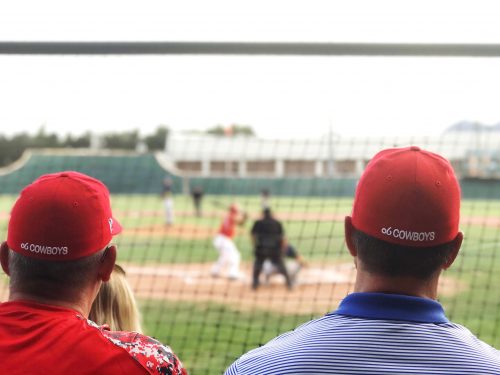
The Cowboys play in the Pecos League, a professional baseball club which is not affiliated with the Major or Minor Baseball League. As the only Pecos League team in Texas, they play against opponents from New Mexico, Arizona, Kansas, Colorado and California. Former Cowboy Austin Prott is the Field Manager and Cavness volunteers 100 percent of her time for her general manager role.
“It’s nice to give back,” said Cavness. “They’re using our tradition and our family name and our brand and that’s why I’m so passionate about it. To continue on that legacy.”
The season typically starts in late May and continues until the end of July (unless they make the playoffs). The players are recruited from all over the United States and some have come as far as Japan and Puerto Rico.
“They have to be Cowboys,” said Cavness. “And by that, they have to be outstanding young gentlemen who have great respect for our tradition and for our community.”
Local families host the players in their homes during the season. As a thank you, the families are given season tickets and are recognized during a game.
Games typically start at 7 pm, and as the bright sun sets for the evening, the summer air cools. Visiting fans welcome the weather change, even if it requires a sweater.
“We love the climate out here,” said Janice.
She also enjoys buying a Nolan Ryan all-beef hot dog from the concession stands. Fans can purchase most food and drinks that are normally found at a baseball game from Frito pies to burritos with Come & Take It BBQ brisket.
“Cowboy games are just special for visiting people to do,” said Victor. “It’s hometown-like.”
“They’ve attended more Cowboy games than most Alpine people,” said retired Sul Ross Professor Sam Davis.
But Davis himself has also been a regular fixture at Kokernot Field. The baseball fan has by his estimate only missed 10 games since the team returned in 2009, and has been a season ticket holder every year. A perk of having season tickets is that he can reserve his seat before the season starts. He picks the same seat in the middle section that gives him the perfect view of the pitcher.
“I can criticize the umpire from here,” Davis joked. “I can see better than he can.”
It’s not hard to notice Davis with the white binder on his lap. Throughout the game, he tracks every play from both teams on scorecards. He uses a pencil with a long twistable eraser, because he “makes mistakes,” and he keeps the pages from the games in a larger notebook at home. This is simply a pastime for Davis.
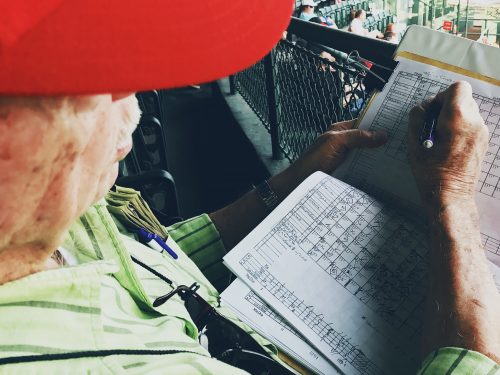
“It makes the games more interesting,” said Davis.
Cowgirl Rubi Losoya keeps the crowd moving with mini-games such as the dizzy bat spin and beach ball bounce in between innings. She runs around the stands to collect money in a cowboy hat whenever a player makes a home run. That money goes directly to the player. This all adds to the small town fun at the baseball game.
“It’s just neat to be part of a historical baseball park,” said Cavness.

Article and photos by Sarah Vasquez
Live Music
MUSIC FRIENDLY COMMUNITY
Alpine is home to lots of wonderful musicians and welcomes many more to perform here. And we are a certified “Music Friendly Community”!
The program is part of the governors Texas Music Office. Being a Music Friendly Community provides support for both the artists and the economy of Alpine. The music industry has a multi-billion dollar impact on the Texas economy annually and creates thousands of jobs in both large and small communities.
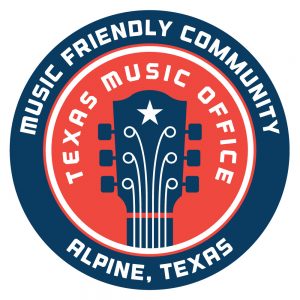
Alpine had to meet several criteria to become a certified “Music Friendly Community” and made in official in July of 2020. As part of the criteria the City of Alpine has a Music Advisory Board and a liaison to work with this board and the Texas Music Office. The seven-member Alpine Music Advisory Board is comprised of musicians, venue operators, event organizers and educators from Alpine’s small but vibrant musical community. Alpine’s liaison to the Texas Music Office is Director of Tourism Chris Ruggia. The current board members can be found on on the City of Alpine website Music Advisory Board.
LIVE MUSIC VENUES
In a town of 6,000 residents, the music Neil Trammell has seen in Alpine has been amazingly diverse. “If you look, you can find what you want,” said Trammell, singer for local band The Doodlin’ Hogwallops. “Have an open mind and an open ear, you’ll have a good time.”
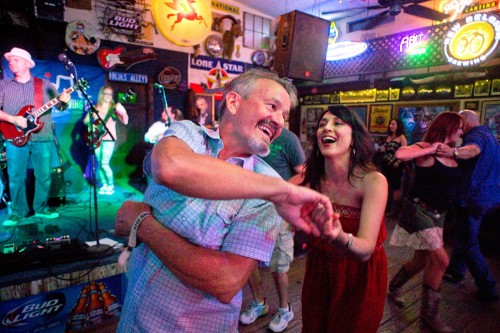
Photo by Michael Howard
Railroad Blues
Prolific music acts such as Jerry Jeff Walker, Del Castillo, Billy Joe Shaver and Kinky Friedman have graced the stage at Railroad Blues. The venue that sits on US-90/Holland Avenue and parallel to the railroad tracks was named by Texas Monthly as one of the “Best Small Town Live Music Clubs in Texas” in 1999.
Out of the almost 20 years he co-owned Railroad Blues, Richard Fallon’s favorite memory was seeing the African reggae band, Tidal Waves. But seeing Ian McLagan, from the British band Small Faces, was another favorite moment for him. McLagan was one of Fallon’s icons during his teen years, so to run sound for him in his bar and share a drink with him was surreal.
In 2013, Railroad Blues entered a new era when it was purchased by Tim Wilson of El Paso, who made sure to keep the spirit of the original Blues. In addition to bringing in live music they host karaoke, a weekly jam session and are the prime location for Viva Big Bend! The Blues has hosted the final show of every Viva with local favorites the Doodlin’ Hogwallops!
The Ritchey
The newest hot spot for live music, usually hosting at least 5 shows a week, is one of the oldest commercial structures standing in Alpine. The Ritchey has been lovingly restored and is under new ownership. They bring a great mix of artists to the stage hosting locals and musicians traveling through the Big Bend region on tours through the west. The courtyard is perfect for the lovely desert nights and if it’s chilly the party moves inside. Look for another indoor music space coming in the next year!
The Granada Theatre & Alcove Social
A classic movie house renovated into Alpine’s premier events venue, the Granada Theatre is one of the largest spaces for live music! In addition to large events and shows they host weekly local singers and small bands in the neighboring bar, Alcove Social. Both venues are available for private parties and can be
The Holland Hotel
The historic Holland Hotel is Alpine’s classic railroad hotel. The current building was opened in 1928 and designed by famed El Paso architects Trost & Trost. The Holland and its restaurant, The Century Bar & Grill, offers occasional live music in a beautiful enclosed courtyard or the elegant historic lobby, depending on the weather. The Holland serves as the Box Office for Viva Big Bend hosting FREE shows during the afternoon as festival goers get to town to pickup wristbands and purchase Viva souvenirs!
Amigo
The Amigo is making it’s mark on the Alpine music scene thanks to their Tuesday open mics hosted weekly by Alpine musician Donnie Bason. There is a core group of talent that kick things off then others are welcome to join in and take a turn on stage. This weekly gathering is popular among all the local musicians giving them a chance to jam together and form new acts. The Amigo also host live music most weekends and is an official venue during Viva Big Bend hosting shows Friday and Saturday night during the festival!
Ole Crystal Bar
Long known as Alpine’s honky tonk Ole Crystal Bar was reopened in March 2017 under new ownership. They bring in popular country music bands to the new large outdoor stage and host annual biker rally that features DJs, live music and contests.
Other Venues
Sometimes a musician doesn’t need an official stage to play in Alpine. The Alpine Visitor Center hosts music under the pavilion, on the porch or even a music circle on the front lawn! Live music can pop up on the patio at Cow Dog Food Truck just because, Cedar Coffee for Poetry Slam, Skelton’s Runway special events, American Legion benefits and anywhere in between.
Luthier Michael Stevens
Custom guitar maker Michael Stevens has done repairs and custom work for guitar legends with the likes of Asleep at the Wheel’s Ray Benson, Stevie Ray and Jimmie Vaughan. He is most known for creating the Christopher Cross’ double neck guitar and the Guit-steel guitar that features a double neck slide/guitar for Junior Brown. Stevens was recently honored by Fender with a limited edition guitar built as a homage to the first guitar he built at Fender’s Custom Shop in 1987.
RingTail Records
Located on the same block as the Granada Theater, RingTail Records is the record store in Far West Texas where you can find a variety of vinyl, cassettes and CDs, and occasionally get a peek at the “secret” murals along the store’s west wall – but only when the “Dog Yard” door is open. What you can’t find in the store can be ordered with the owner Michael McCollum.
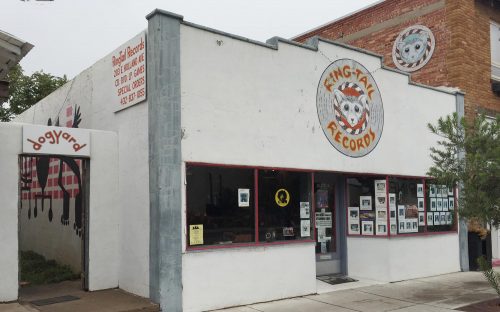
RingTail Records
Music Events
From the annual Lone Star Cowboy Poetry Gathering, Big Bend Bluegrass Festival and ArtWalk, music seeps into the town on a fairly regular basis. Every summer, Viva Big Bend music festival brings over 60 bands for a long weekend not only to Alpine, but to the surrounding towns: Marfa, Marathon and Fort Davis. Grammy award-winning Los Lonely Boys, Little Joe, Ruben Ramos as well as Texas Tornados and Dale Watson are some of the past festival headliners. Other notable acts to make the trek to play Viva Big Bend include Shakey Graves, Gina Chavez, Grupo Fantasma, Shinyribs and The Peterson Brothers.
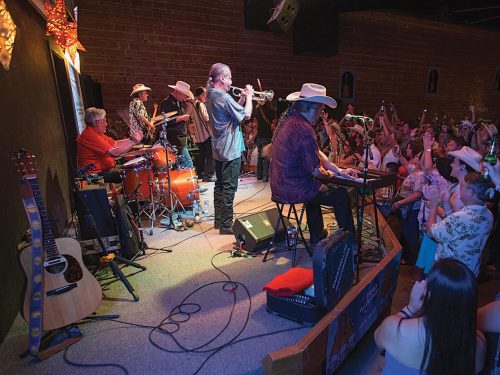
The Texas Tornados at Viva Big Bend. Photo by J. Griffis Smith.
With the closest commercial airport at least 3 hours away, getting to Alpine requires a detour from the convenient I-10 highway. One can ride the Amtrak train directly to Alpine though. Alex Pianovich did just that by riding the 26-hour long train ride with his girlfriend from New Orleans a few years ago. The landscape and the climate enchanted the musician, but it was discovering the small town’s deep appreciation for music and art that continuously pulls him back.
His band, Greazy Alice, was a new band when he made that first trip, but the singer knew he wanted to bring his band to perform. When they first played in Alpine, they traveled from Joplin, Missouri. Pianovich’s band members weren’t particularly happy with him for booking a show in the middle of the desert, but he told them to trust him.
“It seems like an anomaly until you go there,” said Pianovich. “How does a town of 6,000 people do it, but then you go there and it makes sense.”
Updated from an original article by Sarah Vasquez
Historic Walking Tour
Pick up a complete brochure of the Historic Walking Tour of downtown Alpine (plus a larger historic windshield tour) from the Alpine Visitor Center at the corner of Avenue E & 3rd Street. You can also download a printable version here (map only).
The tour begins at the Railroad Depot (Holland Avenue & 5th Street) and concludes across Avenue E from the Brewster County Courthouse.
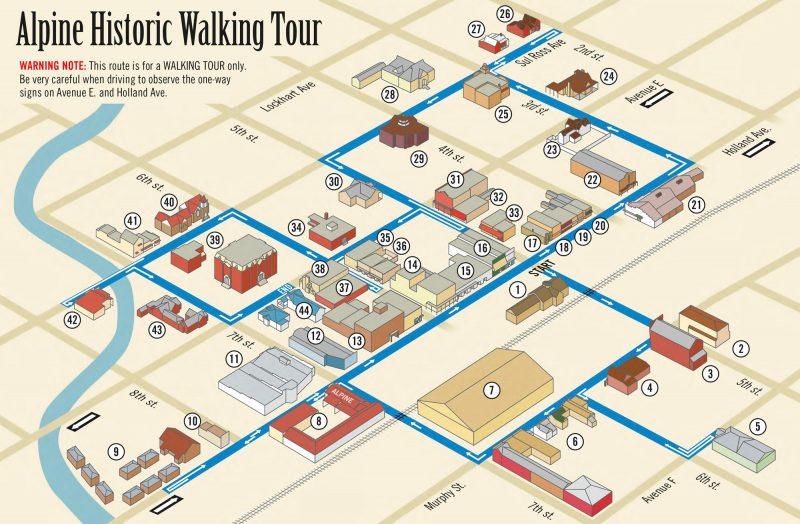
Look for numbered markers at each location on your walk.
1. The present railroad station is the fourth depot built on this site. It was constructed after a January 1946 fire destroyed the old structure. The previous depot buildings were destroyed by fires in 1888 and 1901.
2. Ritchey Hotel is one of the oldest commercial buildings still standing in Alpine. The adobe portion was built in the 1880s as a hotel. The frame addition was made in 1908.
3. The Valadez Grocery and furniture store was built about 1898.
4. The Alpine Studio, built in 1907 by pioneer photographer John Thain as his studio, was remodeled to Mission style in 1928.
5. The Valadez house was built in 1890 by Trinidad Garcia. It served as a social center until it became the residence of Tomas Valadez in 1926.
6. One of the oldest blocks in Alpine, housing businesses and residences. The west corner building was formerly a frontier saloon.
7. Big Bend Wool & Mohair was in continuous operation for over 60 years after its construction in the 1940s.
8. This property, constructed prior to 1920, was Alpine’s second lumber yard; the original building faced 7th St. and was later turned to face Holland Ave.
9. Motor court, built around 1930. Original wood cabins were covered with stone in the mid-1940s.
10. Alpine’s first fire house was built in 1924 to house the town’s new 1923 Ford fire truck.
11. Built in 1924, this was the most modern automobile dealership in West Texas. Renovated in the 1940s.
12. In 1911 this building housed a roller rink. It was the site of the first silent picture shows in Alpine.
13. The current Holland Hotel, designed by Trost & Trost and built in 1928, was added to the original Hotel Holland & State National Bank Building on the corner of 6th & Holland. The original, built in 1912 after the fire, rapidly became the business and social center of Alpine. The 3rd story portion on 6th Street was added in 1922.
14. The Lackey-Hord building, built after the 1911 fire to house the Palace Drug Store and other retail enterprises with offices of doctors and lawyers on the 2nd floor.
15. This row of store fronts, built after the 1911 fire, housed several mercantile operations; notably it later was home to Forchheimer’s Dry Goods and Morrison’s Variety Store.
16. The corner building, built by Mitchell Werth in 1907, has been used for various retail enterprises. The western portion was built in 1905 as the First National Bank. Burned out in 1907 except for its store front, it was immediately rebuilt. In 1935 it became City Hall and served as such until the early 1960s.
17. Built by State Senator Benjamin F. Berkeley in 1929 as a restaurant in the Mission style, it later served as a pool hall and bowling alley.
18. The Berkeley Building, built in 1921, housed traveling shows and vaudeville acts in early years.
19. Three adjoining storefronts to the east were built soon after the theater.
20. Built in 1929, the two stores at the end of the block housed the Cross & Cross women’s shop and the first Safeway in Alpine.
21. Alpine Lumber started in this location in 1904. This facility was built in 1928 & remodeled in the 1960s.
22. Granada Theater, built in 1928, became the major entertainment center of the Big Bend area.
23. The Gage-Van Sickle House was built in 1889.
24. Senator Benjamin F. Berkeley home was built in 1910. The wrought iron fence was originally around the courthouse in 1889.
25. The Methodist Church, an example of Mission Revival style architecture, was built in 1925.
26. The Nolte-Rooney Home, listed on the National Register of Historic Places, was built in 1890 by F. H. Nolte, an early settler in Murphyville (Alpine), of 2 ft. thick adobe bricks made on the site.
27. The Burgess Home was built approximately 1890.
28. The Sunshine House, Alpine’s second public school, was built in 1891. Purchased by the city in 1918, and used at various times as a hospital, Border Patrol station, a girls’ dormitory for Sul Ross, and a Senior Center.
29. The First Baptist Church, built in 1895, was replaced in 1916 by the present church structure.
30. The Burke House, an early adobe residence, was built in 1890 by Dan Carr and later occupied by Burkes for over 50 years.
31. The Masonic Lodge building, built in 1912, housed retail businesses on the ground floor; the second floor was the lodge hall.
32. These three stores were built in 1928, one of which originally housed Hudson’s Bakery.
33. A dry goods store built by Forest Robinson in 1927. Western Union occupied the center storefront. The southern addition was built in 1929.
34. Alpine’s Post Office until September 2000, built in 1939, is typical of WPA architecture. The inside retains most of its original features, including a mural by Moya del Pino.
35. This building was built as M System Grocery in 1948 by Dom Adams.
36. The row of stores known as the Turner Building were built by Otis Turner in 1927 and housed some of the finest apparel stores in Alpine.
37. These two storefronts were constructed around 1927 by Clarence Hord. The left one housed Hord & Williams Grocers and the right one was occupied by The Model Shop run by Frank McCollum with The Model Cleaners in the back run by Jesse Allen.
38. Built by Fuller in 1928, the building originally housed the post office from 1932-1938. City Drug and Highland Drug have both occupied the left side of the building. Dr. Malone Hill purchased the building in 1947. His clinic/hospital was located upstairs.
39. These buildings have stood longer than any other in the downtown area and are among the oldest in Alpine. Construction began on the county courthouse and jail in 1887 when Brewster County broke away from Presidio County.
40. The Christian Church, completed in 1906, had a stone veneer applied in 1940, and an educational annex constructed in 1946.
41. The home of Dean Manufacturing in 1909, this building was purchased by Charles Livingston in 1928 and remodeled into a funeral parlor.
42. The American Legion Building began in 1928 as Allen’s Planery, a planing mill, and was purchased by the Legion in 1935.
43. Built as the home of Otis Morgan in 1929, this building housed the Alpine Public Library from 1950 to 2011. In 1970, the Library expanded to include the Darcy Home (to the south), built in the 1920’s.
44. These two houses, built in the late teens, were purchased in 1945 by Dr. Joel Wright and used as his office and hospital.
Hancock Hill Trails
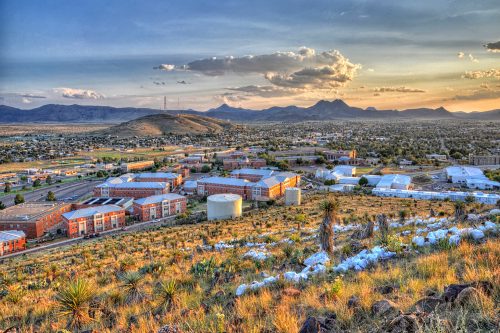
Hancock Hill, behind Sul Ross State University, features a small system of hiking trails on University and private property. A few suggested routes are indicated on the Google Map below, including overlooks of the town and the path to “The Desk” (see below). There are multiple small crossing paths and it is easy to get confused as to which is which, so be careful!
To find the trailhead: turn left at the end of Avenue B (SRSU Entrance 4). The trailhead is at the far edge of the old Mountainside dormitory parking lot.
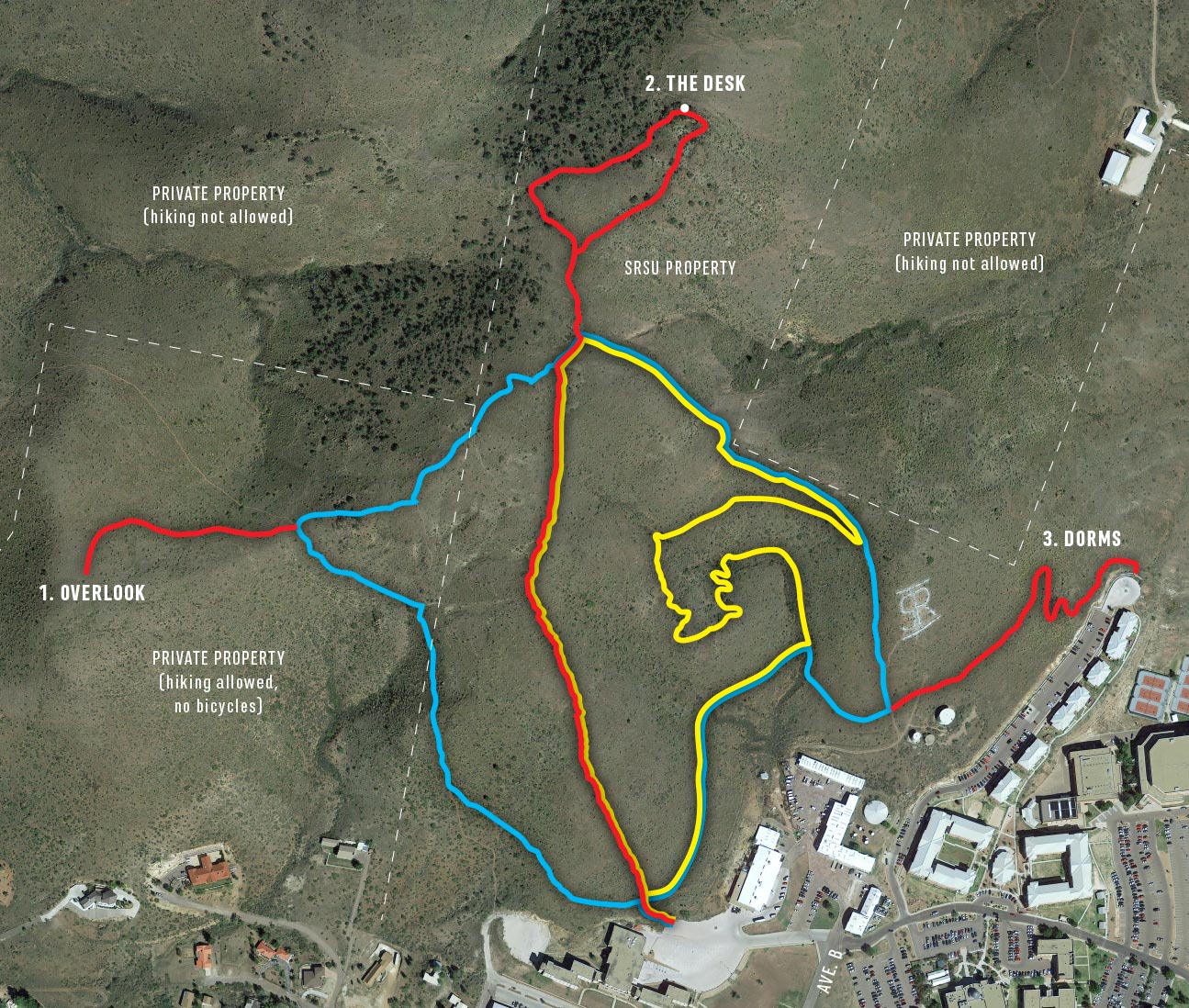
Be sure to bring water and protect yourself from overexposure to the sun. The trails can be rough and rocky, so sturdy footwear is highly recommended. Pets are allowed, but their waste should not be left behind!
Mountain biking is welcome on University property, but NOT on the adjacent private property. Be aware of signs and do not cross fence lines with a bicycle. The trails are considered quite difficult for mountain biking.
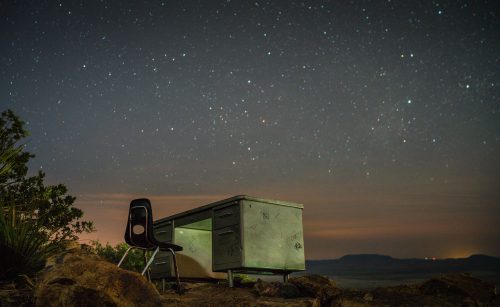
The Desk
In 1981, three Sul Ross students decided they needed a quiet spot away from the dorm to study. Together they carried a desk up Hancock Hill right above Mountainside dormitory. Soon they were spending hours up on the hill studying and enjoying the beautiful surroundings.
One day, one of them left a notebook in one of the desk drawers and when he checked it later, someone had written in it. He replied and soon the tradition of a notebook associated with The Desk was born. 10 years later, the first completed notebooks were brought to the Archives of the Big Bend in the Bryan Wildenthal Memorial Library.
The Desk is located at the eastern edge of Hancock Hill, and is indicated on the Google Map above.
Alpine City Parks
Find a perfect spot and stay a while! Alpine is home to more than 30 acres of beautiful city parks that offer plenty of space to get out and enjoy our sunny days. Kids can run wild and free, dogs unleased in their own space, brisk walks, slow meanders, invigorating runs, bird watching, ball games and so much more for people of any age to get out and PLAY!
Kokernot Park is the largest multi-use park. It is located on the cities northside and offers something for everyone, even your 4-legged friends!
Families with younger children and toddlers will be pleased to find so many spaces specifically designed for their kids enjoyment and safety. The 1400 square foot shaded play area for toddlers and infants has small age-appropriate equipment and sensory toys. Not only are children protected from the sun but also from hard falls thanks to the entire play area being on rubber mats. It is also partially enclosed to keep your little ones from running too far. And not far from the play area is a set of 6 shaded swings that includes 2 infant bucket seats and there is also an ADA wheelchair accessible swing set with paved access.
As your children’s climbing abilities grow so does the equipment with 2 additional play areas with more advanced activities. All the playground equipment is located within viewing distance of each other so parents can keep a watchful eye on kids of all ages while they play or dig in the huge sandbox. There are also several benches that offer parents views of all the playing areas and tree-shaded picnic tables and grills for relaxing.
If you want to get in some steps and enjoy beautiful views of Alpine Kokernot Park has an extensive network of walking trails that will take you around the park, golf course, across the bridge and back again! There area also fitness stations scattered along the trail. You are welcome to bring leashed dogs on the walking paths with you as there are dog waste bag stations throughout the park. There is also a dog park that provides your animals a place to run free.
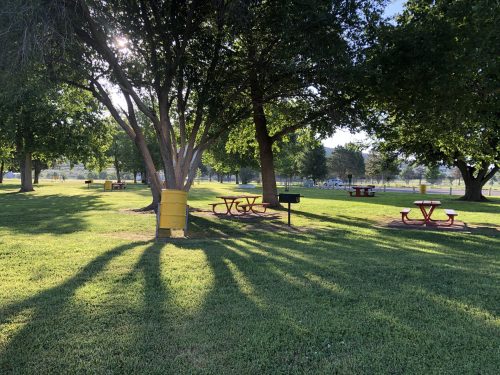
Kokernot Park is also home to lots of facilities for team sports competitions and practices. There are soccer fields, baseball fields, tennis courts and a sand volleyball court. Next to the baseball fields is Kokernot Field with it’s trademark “06” brand, Built is 1947 this baseball stadium is home to Alpine’s professional baseball team, the Cowboys. Learn more about the team’s wonderful history here https://visitalpinetx.com/attractions/#alpine-cowboys-baseball.
There is also a skate park that offers a safe place to enjoy various jumps and ramps.
The swimming pool at Kokernot is the only public use pool in Alpine and operates seasonally from roughly Memorial Day to Labor Day.
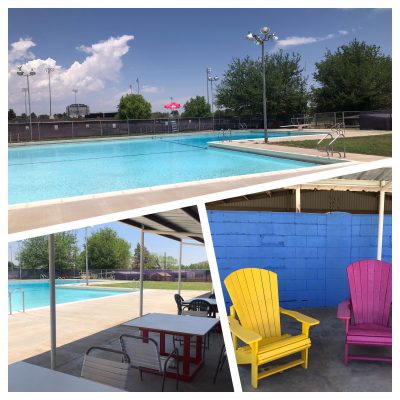
https://www.cityofalpine.com/visitors/parks_and_recreation/pool/index.php
Next to the pool and overlooking the play areas is a large pavilion that is available for use with a fee and reservations through contacting the City of Alpine Public Works Department by emailing l.mendoza@ci.alpine.tx.us
If you are planning for a fun day at the park it’s best to pack water, snacks and maybe a picnic lunch since there are not any restaurants or convenience stores around the park. There are public restrooms available for use. Kokernot Parks open from dawn to dusk.
Baines Park is located next to Out Lady of Peace Catholic Church at the foot of “A” Mountain on the City’s southside.
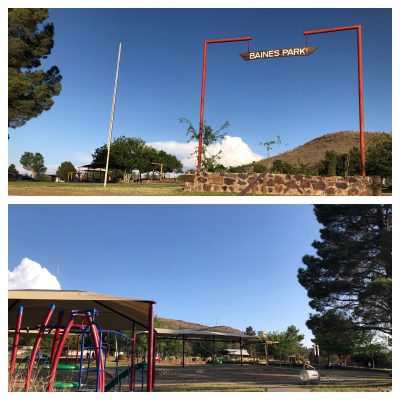
Located just a few blocks from Downtown you will find Baines Park on the windshield portion of the Alpine Historic Tour.
https://visitalpinetx.com/attractions/#historic-walking-tour
Beautifully landscaped with rock walls and native grass Baines Park is a great place to go for a walk or have your Rocky moment running up the stairs. With play equipment for toddlers on up to adults this park offers a great place to stop and enjoy some playtime. There is a full-size basketball court with 8-foot hoops, open grassy areas, 5 covered picnic tables and a 6-seat shaded swing set with 2 infant bucket seats.
The shade covered climbing equipment offers challenges and fun for kids and there is also a plane made from a barrel, or take a ride on the whale or frog.
While there are not pubic restrooms at this park it is close to the downtown area where there are facilities inside the train depot.
Juan Medina Park is another of the 4 parks located on the southside of Alpine.
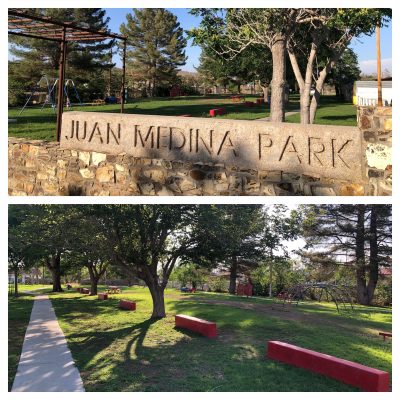
Medina Park is partially enclosed by a chain link fence since it is located along Alpine Creek. It is a great place to enjoy a short walking loop that encircles the entire park. The swing sets and play equipment is targeted for younger kids ages 0-5. In addition to the climbing and balancing equipment there are play stations to spark the imagination and engage kids senses. Your kids can even pretend to be the train engineer with the small stationary toy train built from barrels.
Medina Park has picnic tables and grills available for use. There are no restrooms at this park but public facilities are available at nearby Centennial Park.
Centennial Park is another park you will find on the windshield portion of the Alpine Historic Tour since it located next to the historic Centennial School.
This park is geared for competitive sports competitions and practices with a full-size basketball court and baseball field.
It offers a quiet area for walking and new restroom facilities.
Pueblo Nuevo is under construction!
The final park located on the City’s southside and is in the process of undergoing a major renovation. Look for exciting things to come!!
Railroad Park is the final park to enjoy here in Alpine. It is an urban green space located right in the heart of Downtown Alpine.
Railroad Park is beautifully maintained by local volunteers and offers a wonderful place to take a break while sightseeing and shopping in vibrant Downtown Alpine! From the shaded benches you can enjoy several of the famous large murals that decorate many of the downtown buildings. https://visitalpinetx.com/attractions/#alpine-murals
The park is also home to 2 sculptures honoring Alpine’s history with the railroad. There is even a caboose!
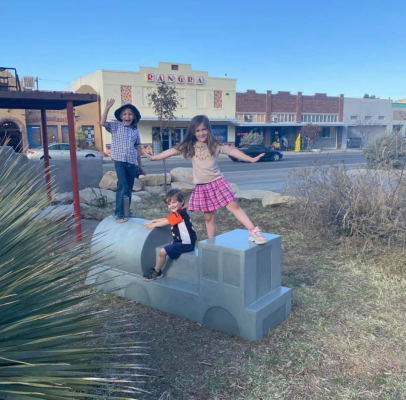
And you can get a drink for your animals too with the complimentary water and bowl.
2024 Summer Activities for Kids
Thank you to Alpine Community Projects and Big Parks and Rec for Kids for putting together this great list of things for kids to do this summer in Alpine. There are sure to be additions and changes along the way. Remember you can always find Weekly Events here https://visitalpinetx.com/events-calendar/
In addition to these special events you will find details below about some of the great attractions for families to explore!
- Please send additional event info to visitorcenter@visitalpinetx.com and check back regularly for Updates!!
JULY:
Tuesdays (7/2, 7/9, 7/16, 7/23, 7/30)
Adventure Begins at APL! 3-5pm Ages 6-12. Located at APL. Each session begins with 30 minutes of playful exercise, followed by a popsicle break and ends with themed reading and activities. For more info: https://alpinepubliclibrary.org/youth/
Wednesdays (7/3, 7/10, 7/17, 7/24, 7/31)
Cubelets 9:30-11am. Ages 6-12. Located at APL. Build Robots that spin, squeak, and sing! For more info: https://alpinepubliclibrary.org/youth/
Saturday & Sunday 7/6-7/7
SRSU Girls Elite Basketball Camp 9a-Noon and 2:30-5:30p. Grades 9-12. Cost is $150 for an on-campus experience which includes two meals and a room for one night while off-campus is $100. Deadline for applying is Saturday, June 15. ttps://srlobos.com/sports/2021/8/27/hometown-tickets-page.aspx
Thursdays (7/11, 7/18, 7/25)
Toddler Time 10-11am. Ages 0-5. Located at APL. Story Time, finger plays, singing, dancing, crafting, parachute play, exploration centers. For more info: https://alpinepubliclibrary.org/youth/
Fridays (7/5, 7/12, 7/19, 7/26)
TinkerCad Open Lab 10am-Noon at Alpine Public Library (APL) Come learn the basics of 3D design and make models of your ideas! For more info: https://alpinepubliclibrary.org/youth/
Monday-Friday 7/8-7/12
Alpine Summer Music School: Music of the Middle Ages 9am-3pm. Kids 7-12; teens 13-17. For more info: https://www.alpineschoolofmusic.com/summer-school-i
Saturday 7/13
Grow your Curiosity 9am- Noon. Kid’s activities at the Alpine Farmer’s Market. All ages.
Monday-Friday 7/15-7/19 (9a-2p)
SRSU Children’s Summer Theater Camp! 9am-Noon. Ages 7-12. To register go to https://sulross.hometownticketing.com/embed/event/201?es=ueh24d89lgfolf2ogfee0fbrua&single=1
Monday-Friday 7/22-7/26
Discovering Flora and Fauna of the Big Bend 9am-Noon, Summer Art Camp for Kids at Museum of the Big Bend, Grades 3-5. The cost is $50 per child. Space is limited to 20 kids so enroll today! Contact & Registration Info: Rebekah.Antrosio@sulross.edu or call 432-837-8143.
Thursday & Friday 7/25 & 7/26
Soccer Skills Camp
Sul Ross Soccer is hosting for all experience levels ages 7 to 15.
Only $30 per day.
Please register here: https://srlobos.com/…/2021/8/27/hometown-tickets-page.aspx
Saturday 7/27
Viva Big Bend Kid’s Show with Mr. Will 11am. at the Alpine Visitor’s center. All ages. https://vivabigbend.com/
AUGUST:
Saturday 8/3
Grow your Curiosity 9am- Noon. Kid’s activities at the Alpine Farmer’s Market. All ages.
Tuesday 8/6
Adventure Begins at APL! 3-5pm. Ages 6-12. Located at APL. Each session begins with 30 minutes of playful exercise, followed by a popsicle break and ends with themed reading and activities. For more info: https://alpinepubliclibrary.org/youth/
Wednesday 8/7
Cubelets 9:30-11am. Ages 6-12. Located at APL. Build Robots that spin, squeak, and sing! For more info: https://alpinepubliclibrary.org/youth/
Thursdays (8/8, 8/15, 8/22, 8/29)
Toddler Time 10-11am. Ages 0-5. Located at APL. Story Time, finger plays, singing, dancing, crafting, parachute play, exploration centers. For more info: https://alpinepubliclibrary.org/youth/
Fridays (8/2, 8/9)
TinkerCad Open Lab 10am-Noon. At Alpine Public Library (APL) Come learn the basics of 3D design and make models of your ideas! For more info: https://alpinepubliclibrary.org/youth/
family adventures
Room to Play
Finding wonderful places for families to run and play is literally a walk in the park here in Alpine! There are so many City parks to enjoy with each one offering different attractions and amenities. Get details about what each park offers
https://visitalpinetx.com/attractions/#alpine-city-parks
Alpine Public Pool
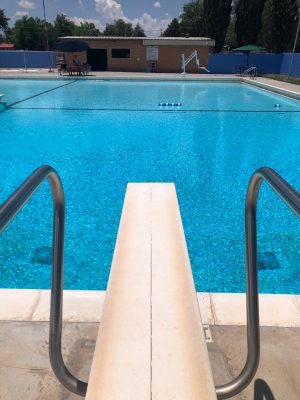
Get ready for low cost summer fun at it’s finest! The Alpine Public Pool is a great place to cool off after a day of play or spend the day there relaxing! The pool is located in Kokernot Park and is open everyday. In addition to the general admission times there are designated lap swim and adult swim times. You can also have the whole place to yourself by booking a private party!
The pool offers both shallow and deeper water for swimmers of all levels, a diving board, and a handicap chair.
There are tables and lounging chairs that offer cover from the hot sun and several umbrella covered tables too. The facility also has showers, restrooms and changing rooms available on site.
Certified lifeguards are always on duty to ensure the safety of all guests and everyone is expected to follow established facility rules and regulations as instructed. To get all the latest information on hours of operation and rates visit the City of Alpine website https://www.cityofalpine.com/visitors/parks_and_recreation/pool/index.php
Rest Stop and Info for Tiny Travelers
Alpine Visitor Center has lots of information and fun for kids too! We have coloring pages that teach Texas history, Take Care of Texas activity books, water conservation activity guide and Don’t Mess with Texas activity books. And we love to display artwork and coloring done by our visitors!
Outside kids can pretend to be a cowboy in our mural or with the metal art cowboys that are resting on the fence. There is also a rock garden to play in, old fashioned hopscotch, and sidewalk chalk to create their own masterpiece!
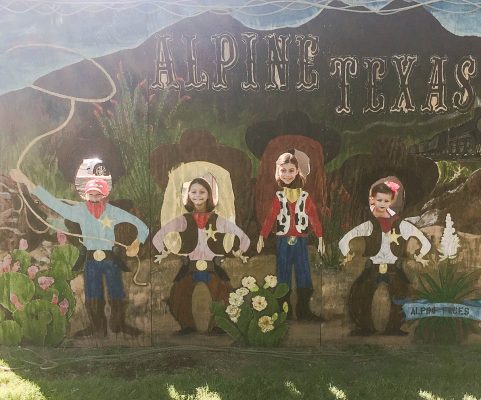
On our lawn families can enjoy a picnic lunch or snack from one of the area food trucks. We have several benches, a couple picnic tables or and a great big porch perfect for hanging out!
And sometimes the most important amenity of all… YES we have a public restroom!
Educational Experiences
With so many opportunities to get up close with nature here in the Big Bend the educational opportunities are endless and SO MUCH FUN!!
The Museum of the Big Bend “The Museum of the Big Bend gives parents and their children a place to learn about the area together, creating a shared learning experience. The Museum feels that this a great opportunity for everyone to have the opportunity to have a better understanding of this unique place in Texas.”
Museum Director Mary Bones says most children like the dinosaurs best, “For our young scholars, the Museum has been a source of wonder and knowledge of the Big Bend’s pterosaur, Quetzalcoatulus northropi. We have a to scale model of this amazing animal suspended from the ceiling of the Museum. Additionally, we have a video about Big Bend dinosaurs in our exhibit area.”
They also really like this little guy…
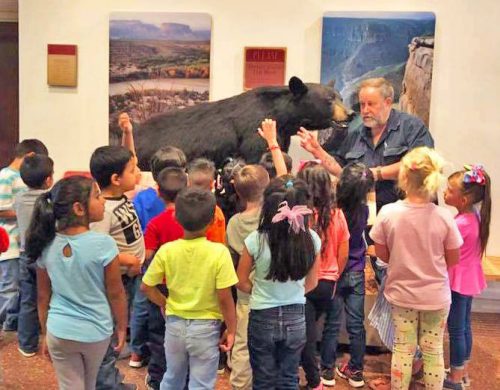
For more information on the Museum of the Big Bend and to see what children’s programs are currently being offered go to https://www.museumofthebigbend.com/learn/
McDonald Observatory, located in the Davis Mountains north of Alpine, offers amazing programs to teach you about the beautiful night sky in West Texas. The late night star gazing parties are a popular choice for visitors to the Big Bend but not always good for families with little ones. Luckily you can still have a great experience and learn all about astronomy with a daytime visit to the Education and Visitor Center or by taking a Guided Tour. Be warned the gift shop is full of so many cool things!! For more about how to book your visit go to https://mcdonaldobservatory.org/visitors
You will find wide open spaces and endless opportunities for engagement and learning at the Chihuahuan Desert Nature Center. Lisa Gordon, Director CDRI, she says interacting with visitors, no matter their age, is the most fun part of working there. “Children love to be outdoors and what better place to introduce them to nature! It’s a great place for children to burn up a lot of energy too! They love the path over the rock outcropping behind the Pollinator Garden. Children love to explore and climb on the rocks.”
The Nature Center is located just off Highway 118 between Alpine and Fort Davis and includes exhibits, botanical gardens and tons of trails. Gordon, “I think one of my fondest memories is of the dad who brought his two sons, ages 4 and 5 years old, to hike up to Clayton’s Overlook. That hill goes up 220 feet, and it’s a mile and a half hike, so it’s a pretty strenuous hike. The dad asked his boys if they were ready to climb Mt. Everest. The boys were excited, and the three of them set out on their hike. Needless to say, the boys returned to gleefully tell me that they had hiked to the top of Mt. Everest and then telling me all about seeing a herd of aoudad! That was followed by the younger of the two saying, “I’m tired now, so I’m going home to take a nap.'”
Visit the Nature Centers website for more information on admission and hours of operations as well as their children’s programs. http://www.cdri.org/students–groups.html
Ranger Programs

“I want to be a Park Ranger!” Don’t be surprised if this gets added to the list of jobs your child wants after spending some time here in the great outdoors.
The Junior Ranger programs in the state and national parks can get them started on that path! They offer free learning materials that allows your little ones to write and draw about what they see while out exploring nature. Kids can complete the Junior Ranger Journal for each park and work towards earning their Junior Ranger Pin and badges.
The Junior Ranger Program is available at these parks in the Big Bend!
Davis Mountains State Park
https://tpwd.texas.gov/state-parks/davis-mountains
Fort Davis Historical Site
https://www.nps.gov/foda/learn/kidsyouth/beajuniorranger.htm
Big Bend National Park https://www.nps.gov/bibe/learn/kidsyouth/becomeajuniorranger.htm\
Big Bend Ranch State Park
http://tpwd.texas.gov/spdest/programs/jr_ranger/
Animal Encounters
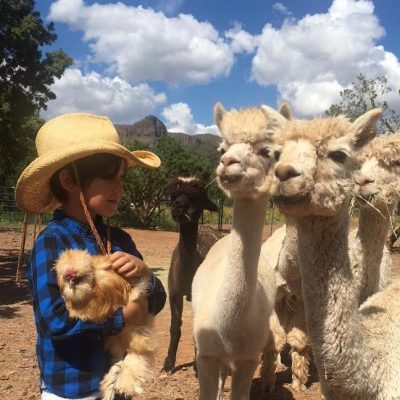
Wassermann Wranch is family fun at its best!
The “wranch” is owned and operated by Scott and Heidi Wassermann. ” Heidi loves to give families a personal experience, “I LOVE it when kiddos who have no experience around equines take the lead rope of our miniature horse, Spur, and lead him past their parents. The kids beam with pride having never done anything like it before. I like to watch the “quiet and shy” kiddo slip away from the group to pet our gentle, 30+ year old Mammoth donkey, Chewbakkah, and carry on a private conversation with him.
I love asking “Who was your favorite animal?” and finding out there was, indeed, a specific animal that touched somebody’s heart for one reason or another. “
See how you can book a day of adventure that your kids will never forget
https://visitalpinetx.com/wassermann-wranch/
It’s often said that if you get a kid horseback the horse will do the rest. Children are naturally attracted to horses and riding is a perfect way to teach them so many skills, like patience, listening, respect and confidence.
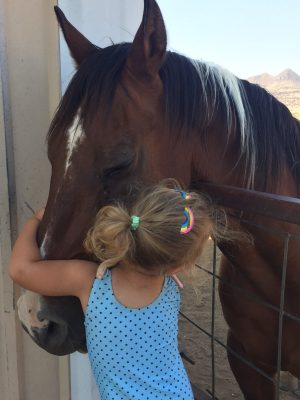
The historic Prude Ranch located in Davis Mountains about 35 minutes north of Alpine offers rides that are a perfect way to introduce children to horses and take in the beauty of West Texas! They offer 1-hour and 2-hour rides.
Advanced reservations are required and there are special discounts available.
http://prude-ranch.com/horse-corrals/
If you want to give your kids a week of outdoor fun Prude Ranch also offers summer camps. While the kids are at camp you can enjoy the week doing some adults only activities and relax at one of the beautiful boutique hotels here in Alpine.
If your family is beginners or more experienced riders looking for a longer adventure horseback then Lajitas Stables and Big Bend Stables have lots of options to pick from. Both stables are located between Big Bend National Park and Big Bend Ranch State Park. The rides are anywhere from 1 hour, half a day, all day and even multiple day rides. Walk-ins are welcome but reservations are highly recommended to make sure they can accommodate you!
https://lajitasstables.com/
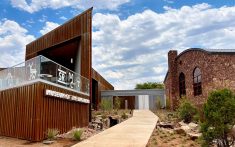
Museum of the Big Bend
Located on the beautiful campus of Sul Ross State University, the Museum of the Big Bend is a must-see for each visitor to the area. It is a wonderful repository of information on the entire Big Bend region with exhibits that celebrate the Chihuahua Desert and highlight the historic and prehistoric history of the area. In June 2023 the Emmett and Miriam McCoy Building addition celebrated its grand opening. The 10,000-square-foot, $11 million expansion doubled the museum’s size and added multiple galleries showcasing artworks that interpret the landscapes, cultures, and history of far West Texas. The collections tell a fuller story of the Big Bend’s natural history and regional heritage. Mary Bones, Museum of the Big Bend Director, “The Museum of the Big Bend is your best introduction to the Big Bend area. The Museum uses exhibits loaded with artifacts along with short videos on touch screen kiosks to tell the story of this wonderful country. Make sure to look all around and up as there are many surprises throughout the main exhibit!”
Admission is $10 for adults, members, SRSU students and faculty and kids under 12 are free. Open Tuesday through Saturday 10am-4pm. Visit www.museumofthebigbend.com/ or call (432) 837-8143 for more information.
Open Tuesday- Saturday 10am-4pm.
Alpine Farmers Market
Nestled amidst the stunning vistas of West Texas, Alpine buzzes with a vibrant energy, especially on Saturdays. That’s when the Alpine Farmers Market transforms the Alpine Visitor Center into a haven for fresh produce, handcrafted goods, and friendly faces.
This market is more than just a place to stock up on groceries; it’s a celebration of the community. From the moment you step onto the grounds, you’re greeted by the warm smiles of local vendors, each passionate about sharing their craft.
A Feast for the Senses
You will find the freshest seasonal produce, locally grown herbs, fresh chicken and duck eggs and tons of native plants. Plus fresh bakes goods like organic sourdough bread, fried pies, cookies and even treats for your pups!
But the Alpine Farmers Market offers more than just agricultural delights. Local artisans showcase their talents, tempting you with handcrafted jewelry, pottery, and artwork that captures the essence of the region. You’ll also find an array of unique jams, jellies, and honey, perfect for adding a touch of local flavor to your pantry.

The Heart of the Market: The People
What truly sets the Alpine Farmers Market apart is the heart behind it all. The vendors are your neighbors, passionate about their products and eager to connect with you. They’ll share their stories, farming tips, and favorite recipes. Creating a warm and welcoming atmosphere is the Farmers Market band that generously donates their musical talents most Saturdays. The Alpine Farmers Market also partners with local groups to offer special events to teach kids about agriculture!
Whether your from Alpine or visiting start your Saturday morning off by shopping local from 9am to noon at the Alpine Farmers Market.
If you are interested in being a vendor you can download the vendor packet here. https://visitalpinetx.com/wp-content/uploads/2024/06/Alpine-Farmers-Market-Vendor-Packet.pdf Please email us at visitorcenter@visitalpinetx.com with any questions.
Big Bend Parks
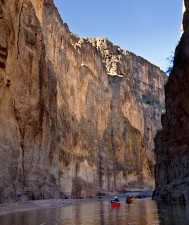
Rafting the Rio Grande courtesy of TXDoT
Big Bend National Park
Big Bend is grand in scope at over 800,000 acres. Take a ride down in the early morning to explore the diverse biology and geology that make for a variety of scenic trails and incredible vistas. Visitors come from all over the world for hiking, backpacking, camping amongst the high Chisos mountains, down by the banks of the Rio Grande, and across the desert brush. Make all the preparations you need for an expedition down to the park: wear appropriate clothing, carry plenty of water, and call the park for more visitor information at (432) 477-2251, or visit www.nps.gov/bibe/.
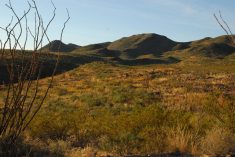
Big Bend Ranch courtesy of Texas Mountain Trail
Big Bend Ranch State Park
Just west of the national park is Big Bend Ranch State Park, featuring over 300,000 acres of wilderness. A favorite among locals for its miles of rugged and remote backcountry trails, the park is a great venue for mountain biking, horseback riding, and canoe excursions on the Rio Grande. Find out more information by calling the Big Bend Ranch State Park visitor center at (432) 424-3327 or visiting www.tpwd.state.tx.us.
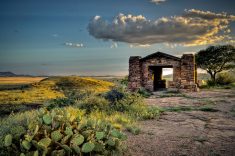
Davis Mountains State Park photo by Chase Fountain
Davis Mountains State Park
Majestic, remote and full of adventure the Davis Mountains State Park high in the mountains of West Texas is a beautiful and historic park. Formed by volcanoes and sculpted by wind and water, the Davis Mountains rise more than 8,300 feet above sea level out of the expansive Chihuahuan Desert.
The state park is 4 miles from the town of Fort Davis at the southeast edge of the mountains. Fort Davis is just 25 miles north of Alpine making it a great day trip.Visitors can enjoy over 20 miles of hiking trails, backpack, mountain bike, ride your own horse, take a scenic drive through the mountains, go camping, stargaze, geocache and study nature.
The Davis Mountains State Park is also home to Indian Lodge. Originally a 16-room hotel when constructed in the 1930’s this unique adobe-style hotel now was 39 rooms, a restaurant, swimming pool (for Lodge guests only) and meeting rooms.
You can also stay at one of the many campsites or rent a group picnic area your next gathering. Find more information by calling (432) 426-3337 or visiting www.tpwd.state.tx.us.
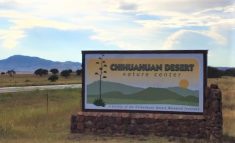
Chihuahuan Desert Nature Center
A quick ride north of Alpine is the Chihuahuan Desert Nature Center, a facility established by the Chihuahuan Desert Research Institute. This 500-acre family and dog friendly facility is an interesting blend of informative exhibits and programs. You will discover an 18 acre botanical garden with a 1/2 mile trail through a diverse collection of labeled native plants, a cactus museum greenhouse and several miles of picturesque hikes with spectacular views of the Davis Mountains. CDRI is open seven days a week through Labor Day weekend. Check their website for hours of operation and information on exhibits or hiking, visit www.cdri.org or call CDRI at (432) 364-2499.
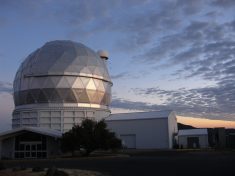
McDonald Observatory by Pete Szilagyi
courtesy of Texas Mountain Trail
McDonald Observatory
Trek north, through Fort Davis, to the famous astronomical research facility, the McDonald Observatory. Informative and detailed tours teach guests about heavenly bodies and the tools used to study them. Plan ahead to attend their famous Star Parties, where visitors get closeup views of the dark skies of West Texas through some of the largest telescopes in the world. Visit mcdonaldobservatory.org or call 432-426-3640 for more information.
Photographing the Big Bend
The dramatic landscapes, diverse wildlife, historical sites, and dark skies are just some of reasons the Big Bend Region is a photographer’s dream.
The towering Chihuahuan Desert mountains make for dramatic landscapes and highlight the stark beauty of our high desert. That landscape changes with every passing hour as it is bathed in sun’s rays. Sunrises and sunsets in Big Bend are legendary. As the sun dips below the horizon, the sky explodes in fiery oranges, deep purples, and cotton candy pinks. Photographers love the “golden hour” as light paints the desert in a warm glow.

Don’t be fooled into thinking the magic only happens at sunrise and sunset. The midday sun, while harsh, can be used creatively to create stark, high-contrast images. Look for opportunities to use shadows to frame your subject or create a sense of mystery. And all this is before celestial wonders of the night sky come to life once darkness sets in here the Greater Big Bend International Dark Sky Reserve.
For astrophotographers, the night sky is their canvas, and few places offer a more inspiring backdrop than the heart of the Big Bend Region, which boasts some of the darkest skies in the lower 48 states. The night sky explodes with a million glittering stars, the Milky Way stretches across the heavens, while distant galaxies, nebulae, and star clusters become visible to the naked eye. This pristine darkness allows your camera to capture the faintest details of these celestial objects, translating into breathtaking astrophotographs.
The Milky Way season, typically from spring to fall, is a prime time for astrophotographers in Alpine. Using a wide-angle lens and a sturdy tripod, you can capture the Milky Way’s majestic band stretching across the sky. Experiment with different exposures to capture the vibrant colors and dust lanes within our galaxy. Here are some tips to plan your astrophotography adventure in Alpine:
- Research moon phases: For the best views of faint objects, schedule your trip around the new moon when the night sky is darkest.
- Find a dark location: While most of Alpine offers exceptional darkness, venture slightly outside town for even darker skies.
- Public lands like Davis Mountain State Park offer fantastic opportunities.

Capturing photos of Alpine can win you cash prizes and get your work featured in a Visit Alpine advertising campaign! The annual Visit Alpine Photo Contest brings photographers of all levels to capture the unique spirit of our lovely little town. The winning images often portray not just the physical beauty of the Big Bend, but also the emotions it evokes – a sense of adventure, tranquility, or the unique rhythm of life in this special corner of Texas.
Free to enter and open to the public the contest open each summer and closes September 30th with all entries being submitted via the Visit Alpine website. This insures that all photos are judged anonymously and names are only revealed to the judge after prizes are awarded.
You can find a complete list of all the rules and take a look at all the past winners and entries here Alpine Photo Contest.
Win or lose you can be sure that by entering your photos in the Visit Alpine Annual Photo Contest they will be seen and enjoyed by people who love Alpine. We feature photos from the contest everyday on our social media channels https://www.instagram.com/visitalpinetx/ https://www.facebook.com/visitalpinetx.
COMING SOON is the Visit Alpine Photo Contest Gallery!
Featuring each of our 13 H.L. Kokernot Junior Memorial Award First Prize Winners and some of our favorites these photos will be on display at our Alpine Visitor Center located at 106 N 3rd Street. The Alpine Visitor Center is open Monday-Friday from 9am-4pm and Saturday from 9am-Noon.
Balmorhea State Park
Nestled within the arid landscape of the Big Bend Region lies a refreshing surprise: Balmorhea State Park. The world’s largest spring-fed swimming pool, offering a welcome respite from the desert heat and a unique attraction that shouldn’t be missed.
Balmorhea State Park centers around a massive spring-fed pool, built by the Civilian Conservation Corps in the 1930s. Over 15 million gallons of crystal-clear water flow through the pool each day, maintaining a constant temperature of 72-76 degrees Fahrenheit year-round and is perfect for a whole day of fun or a refreshing dip after a day exploring and hiking.

While the pool is the park’s crown jewel, Balmorhea State Park offers more than just a swim. The park is home to the Balmorhea State Park Cienega Project, a recreated desert wetland that serves as a habitat for endangered fish and other wildlife. Visitors can observe these unique species while learning about the delicate desert ecosystem.
Balmorhea State Park is a popular destination, with a limited capacity of 900 visitors per day. To ensure a spot, reservations are recommended, especially on weekends. You need to reserve day passes on the Texas Parks and Wildlife Website. Here you will also find lots of great information about safety, camping, and special programs. The park is open year-round and while the campgrounds have reopened the on-site motel is currently closed for renovations.
Whether you’re seeking a cool escape from the desert heat or a unique natural wonder, Balmorhea State Park is a must-see for visitors to the Big Bend region.
Rocks & Gems
The Alpine area is home to some spectacular stones that are rare and distinctive, including Red Plume, Black Plume and Bouquet Agates. Rock hunters have come to this region for many years to find specimens of these beautiful gemstones, but most of the best hunting places are on private land.
The best opportunities for the public to see and acquire specimens of local rocks are at the annual Alpine Gem & Mineral Show and year-round at Ocotillo Enterprises in downtown Alpine.
If you are a real rockhound and are looking for a hunt there are 3 ranches hosting guided hunts by local experts. You can find all the details at https://www.facebook.com/groups/775245782823113/permalink/1837215916626089
Agate Basics
Agate is a hard, durable mineral made out of quartz (silicon dioxide). It occurs all around the world, in every color, and in many different types of patterns. It is as beautiful as it is versatile: Agate has been used in jewelry and other decorative objects throughout history.
Some of the agate patterns are recognized by name and associated with a particular location. This is the case in the Big Bend region, where Red Plume Agate, Bouquet Agate, Black Plume Agate, and Pom-Pom Agate are just a few of the varieties found.
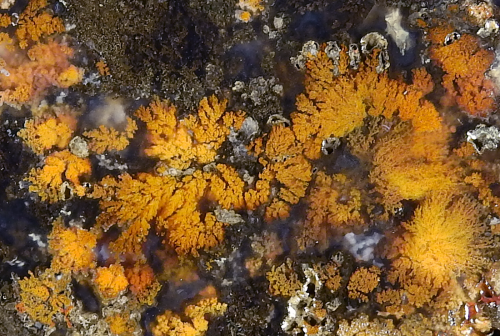
Bouquet Agate – Photo by Steve Ivie / Rockhounding USA
The Big Bend Region of Texas encompasses both volcanic and sedimentary areas. In much of the Big Bend, the volcanic rock did not explode from erupting volcanos, but instead cooled below the surface of the earth. As the magma cooled, heavier elements like metals sank to the bottom of the magma, and the gasses in the magma rose to the top. Millions of these gas pockets were left unfilled when the magma cooled into basalt, allowing the gasses to escape. The agate primarily forms in these empty gas pockets through precipitation (where silica dissolved in water precipitates out and stays in the empty gas pocket, along with trace minerals that cause the colors and patterns). If there are large cracks in the volcanic basalt, agate can grow in there, as well.
The agate that forms in an empty gas pocket is stronger and more durable than the basalt in which it grew. Eventually, the basalt cracks and breaks into small pieces, eventually turning into soil. This process first exposes and then releases the agate contained within the basalt. When first exposed, the agate is usually in the shape of the gas pocket where it formed. An agate in this form is called a “nodule”. Agate nodules in the Big Bend can vary from the size of an English pea to the size of large watermelon. By the time it’s released, however, it may be broken into pieces which don’t resemble the shape of the original nodule at all.
Big Bend Agate
In addition to agate, there are other quartz gemstones that occur in the Big Bend. Jasper, chalcedony, and quartz crystals are three of the most collectible, but there’s also petrified wood, and flint and chert. Different publications define each of these categories differently, but the important thing to remember is that they are all hard, durable stones, suitable for use in jewelry and decorative objects.
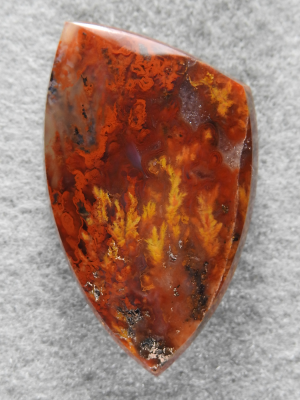
Red Plume Agate – photo © Steve Ivie / Rockhounding USA
You can get some agate of your own by purchasing it, or by going on a rockhunting field trip and finding some yourself. You can purchase agate that is “rough” (just as it looked when it was found), cut into a slab, made into a cabochon gemstone, or set into a piece of jewelry.
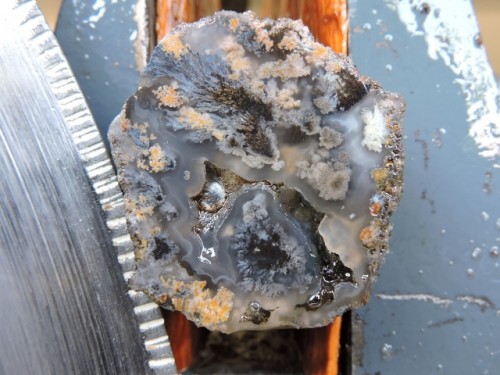
Bouquet Agate – Photo by Brad Tanas
Alpine’s Gem Show
Alpine is host to an annual gem show on the third weekend in April, held at the Alpine Civic Center. This show runs Friday, Saturday and Sunday. Admission is free, and there are vendors from the Big Bend, from Mexico, and from the rest of the world offering you fascinating gems, mineral specimens, and jewelry.
The above text is © Teri Smith, 2016
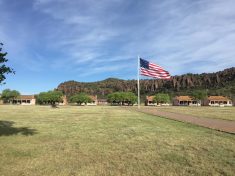
Fort Davis National Historic Site
Established in 1854, Fort Davis National Historic Site stands as a testament to a bygone era of westward expansion and frontier defense. Built on the site of an earlier Native American village, the fort served as a vital safeguard for travelers and commerce along the San Antonio-El Paso Road during a tumultuous period in American history.
Initially constructed to protect against raids by Kiowa, Comanche, and Mescalero Apache tribes, Fort Davis also witnessed the Civil War, with the Union and Confederacy briefly occupying the post. After the war, the fort was rebuilt and became home to famed Buffalo Soldier regiments, including the 9th and 10th Cavalry and the 24th and 25th Infantry.
The town of Fort Davis grew alongside the fort, mirroring its rise and decline. With a population that fluctuated between 500 and 1200, the town served as a hub for settlers escaping the Texas heat, cattlemen, and those seeking a fresh start.
Today, Fort Davis National Historic Site stands as one of the best-preserved frontier military posts in the American Southwest. Visitors can explore meticulously restored buildings like officer’s quarters, barracks, and even a hospital, offering a glimpse into the daily lives of soldiers and their families stationed there.
Beyond the fort’s physical structures lies a rich tapestry of stories. It’s a place where the struggles of Native Americans for survival intertwine with the westward expansion of the United States, creating a melting pot of cultures that included European immigrants, Hispanic residents, and the brave Buffalo Soldiers.
Fort Davis National Historic Site is not just a monument to the past; it’s a living reminder of the significant role the military played in shaping the American West.
The Fort Davis National Historic Site is open 7 days a week from 8am-5pm.
Marfa Art Scene
Marfa, Texas, has become synonymous with art. Whispers of its artistic allure have reached far beyond the dusty plains of West Texas, drawing in art enthusiasts and celebrities alike. But what truly makes Marfa an artistic haven?
In 1979, Judd established the Chinati Foundation, a contemporary art museum dedicated to large-scale permanent installations by a select group of artists. This put Marfa on the international art map.
While the influence of Judd remains undeniable, the town’s artistic allure extends far beyond his legacy. Marfa’s artistic identity isn’t just about the established installations or the art world elite.
Beyond the icons you will find non-profit art space at Ballroom Marfa. Love Marfa is a hidden gem with a witty take that highlights why Marfa isn’t for everyone. Marfa also hosts several art festivals each year including the Marfa Open. The annual event transforms the town into a living art installation, with site-specific works, performances, and artist talks.

Marfa’s vast desert landscape now has a new resident: Sleeping Figure. The colossal sculpture by Los Angeles artist Matt Johnson is constructed from a staggering 12 decommissioned shipping containers, stretches 150 feet long and 40 feet tall, making it impossible to miss.
The sculpture sits on Marfa Invitationals five-acre sculpture park grounds and it’s arrival hasn’t been without controversy. While some hail it as a powerful addition to Marfa’s quirky art scene, reminiscent of Prada Marfa (which is actually west of Valentine, TX), others find its industrial aesthetic jarring against the natural beauty of the desert.
Love it or hate it, Sleeping Figure is undoubtedly a conversation starter. Prepare to be struck by its sheer scale and ponder the questions it raises about art, commerce, and our relationship with the natural world. Unlike the frenetic pace of most art spaces, Marfa allows visitors to truly absorb the works around them. Marfa’s artistic identity lies in the abundance of time and the breathtaking landscape.
For a full list of Marfa’s art galleries go to https://visitmarfa.com/visit/page/arts-culture